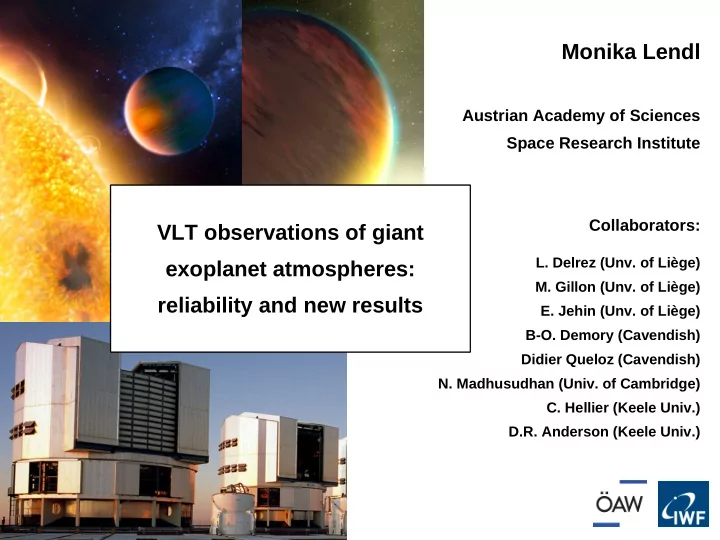

Monika Lendl Austrian Academy of Sciences Space Research Institute Collaborators: VLT observations of giant L. Delrez (Unv. of Liège) exoplanet atmospheres: M. Gillon (Unv. of Liège) reliability and new results E. Jehin (Unv. of Liège) B-O. Demory (Cavendish) Didier Queloz (Cavendish) N. Madhusudhan (Univ. of Cambridge) C. Hellier (Keele Univ.) D.R. Anderson (Keele Univ.)
Good morning!
Transmission spectra Signature of elements in the plantary atmosphere imprinted on stellar light Amplitude Variations in the observed transit radius ;
Targets
Targets
Targets
Observed transmission spectra Diversity is seen in transmission spectra! ● Cloudy/Hazy (e.g. HD189733b): features (largely) obscured ● Clear (or less cloudy...): features visible (e.g. HD209458b) Huitson+ (2012), Sing+ (2008)
Observed transmission spectra Na K H 2 O Clear atmosphere Atmosphere with cloud layer Rayleigh scattering, high-altitude clouds/hazes
Observed transmission spectra ● HST: a reasonable number of transmission spectra with STIS, ACS, WFC3 (e.g. Charbonneau+ (2002), Vidal-Madjar+ (2003) Pont+ (2007), Deming+ (2013)) BUT strong limits on available time, target magnitude ● High resolution spectrographs (e.g. Redfield+ (2008), Wyttenbach (2015) ) BUT small spectral area covered
Ground based observatories Large ground-based observatories for exoplanet transmission spectra ● improved target sample – fainter stars ● more observing time available ● independend measurements ● complementary wavelength regions
Ground based observatories Large ground-based observatories for exoplanet transmission spectra ● improved target sample – fainter stars ● more observing time available ● independend measurements VLT/FORS2 (Bean+ 2010) Magellan (Jordan+ 2013) ● complementary wavelength regions Gemini (Gibson+ 2013)
VLT + FORS2 Our program: WASP-49 with FORS2 at VLT/UT1 4 separate transits (3 observed)
WASP-49b P = 2.78 d R p = 1.12 (5) R J M p = 0.34 (3) M J A hot Saturn with a density of < 0.3 ρ J , predicted to possess an extended ρ p = 0.27 (3) ρ J atmosphere T eq = 1369 (39) K Lendl et al. (2012)
WASP-49 b program Observations ● VLT/FORS2 ● Three full transits ● Multi-object spectroscopy ● 0.7 – 1.02 μm ● Relative spectrophotometry disperse ● Absorption features? ● Instrument stability?
WASP-49 b contamination Contamination ● faint star 2.5 arcsec from WASP-49 identified in the pre-imaging run ● contamination 1-3% ● wide spectral extraction window ● contamination included in the modeling
WASP-49 b spectrophotometry Spectrophotometry extract spectra (wide windows) clean outliers (spatial/temporal) binning 10 nm (20 nm for red end) relative photometry 10 nm bins 27 lightcurves per transit using all references 81 lightcurves in total
WASP-49 b spectrophotometry
FORS2 LADC L inear A tmospheric D ispersion C orrector Uneven transparency Temporally variable Rotating structures on images, strongest at meridian crossing Time-variable flatfield component introducing red noise in lightcurves
FORS2 analysis Parametric CNM Mix
FORS2 analysis Parametric CNM Mix
Parametric baseline
WASP-49 b spectrophotometry
FORS2 analysis Parametric CNM Mix
FORS2 analysis Parametric CNM Mix
Common Noise Model
Common Noise Model
Common Noise Model “white“ transit parameters C ommon N oise M odels
Transmission spectrum -- CNM
FORS2 analysis Parametric CNM Mix
FORS2 analysis Parametric CNM Mix
Transmission spectrum -- mix
Transmission spectrum -- mix
FORS2 analysis Parametric CNM Mix
Combined analysis
WASP-49 b transmission spectrum
FORS2 lessons learned ● Even data affected with the LADC problem can produce reliable results, but systematics need to be taken care of properly. ● WASP-49b: no Na detected, flat spectrum is an appropriate fit. ● With the newly-coated LADC, FORS2 becomes compeditive for transmission spectroscopy.
Recommend
More recommend